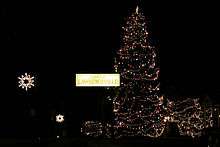Lawrenceville, Illinois
| Lawrenceville | |
| City | |
 Lawrence County Courthouse in Lawrenceville. | |
| Country | United States |
|---|---|
| State | Illinois |
| County | Lawrence |
| Elevation | 469 ft (143 m) |
| Coordinates | 38°43′32″N 87°41′04″W / 38.72556°N 87.68444°WCoordinates: 38°43′32″N 87°41′04″W / 38.72556°N 87.68444°W |
| Area | 2.20 sq mi (6 km2) |
| - land | 2.20 sq mi (6 km2) |
| - water | 0.00 sq mi (0 km2) |
| Population | 4,745 (2000) |
| Density | 2,346.8/sq mi (906/km2) |
| Timezone | CST (UTC−6) |
| - summer (DST) | CDT (UTC−5) |
| Postal code | 62439 |
| Area code | 618 |
|
Location of Lawrenceville within Illinois | |
| Wikimedia Commons: Lawrenceville, Illinois | |
| Website: http://www.lawrencecity.com | |
Lawrenceville is a city in and the county seat of Lawrence County, Illinois, United States,[1] located along the Embarras River. The population was 4,348 at the 2010 census. Lawrenceville is located in southeast Illinois, northwest of Vincennes, Indiana.
The city is home of the Lawrenceville "Indians", Illinois Class A high school state basketball champions in 1972, 1974, and back-to-back in 1982 and 1983, which had a combined two season win-loss record of 68-0. The team was coached by Ron Felling, who, after the 1983 season at Lawrenceville, went on to Indiana University as assistant coach to Bobby Knight.
Geography

Lawrenceville is located at 38°43′32″N 87°41′4″W / 38.72556°N 87.68444°W (38.725686, -87.684538).[2]
According to the 2010 census, Lawrenceville has a total area of 2.2 square miles (5.70 km2), all land.[3]
Demographics
| Historical population | |||
|---|---|---|---|
| Census | Pop. | %± | |
| 1850 | 419 | — | |
| 1860 | 474 | 13.1% | |
| 1870 | 435 | −8.2% | |
| 1880 | 514 | 18.2% | |
| 1890 | 865 | 68.3% | |
| 1900 | 1,300 | 50.3% | |
| 1910 | 3,235 | 148.8% | |
| 1920 | 5,080 | 57.0% | |
| 1930 | 6,303 | 24.1% | |
| 1940 | 6,213 | −1.4% | |
| 1950 | 6,328 | 1.9% | |
| 1960 | 5,492 | −13.2% | |
| 1970 | 5,863 | 6.8% | |
| 1980 | 5,652 | −3.6% | |
| 1990 | 4,897 | −13.4% | |
| 2000 | 4,745 | −3.1% | |
| 2010 | 4,348 | −8.4% | |
| Est. 2015 | 4,427 | [4] | 1.8% |
As of the census[6] of 2000, there were 4,745 people, 2,024 households, and 1,190 families residing in the city. The population density was 2,346.8 people per square mile (907.0/km²). There were 2,262 housing units at an average density of 1,118.8 per square mile (432.4/km²). The racial makeup of the city was 97.85% White, 0.91% African American, 0.08% Native American, 0.23% Asian, 0.40% from other races, and 0.53% from two or more races. Hispanic or Latino of any race were 1.43% of the population.
There were 2,024 households out of which 24.5% had children under the age of 18 living with them, 45.6% were married couples living together, 10.5% had a female householder with no husband present, and 41.2% were non-families. 37.4% of all households were made up of individuals and 20.6% had someone living alone who was 65 years of age or older. The average household size was 2.16 and the average family size was 2.82.
In the city the population was spread out with 20.0% under the age of 18, 7.4% from 18 to 24, 23.7% from 25 to 44, 20.7% from 45 to 64, and 28.2% who were 65 years of age or older. The median age was 44 years. For every 100 females there were 78.0 males. For every 100 females age 18 and over, there were 74.4 males.
The median income for a household in the city was $24,951, and the median income for a family was $32,042. Males had a median income of $27,128 versus $20,451 for females. The per capita income for the city was $16,717. About 13.9% of families and 16.9% of the population were below the poverty line, including 28.7% of those under age 18 and 9.0% of those age 65 or over.
Notable people
- Jason Pargin, pen name (David Wong), is an American humor writer, the executive editor of humor website Cracked.com and has written three novels, John Dies at the End (2007), This Book Is Full of Spiders (2012) and Futuristic Violence and Fancy Suits (2015). John Dies at the End was adapted into a film of the same name in 2012.
- Mordecai Brown, Hall of Fame pitcher for Chicago Cubs and St. Louis Cardinals; previously lived in Lawrenceville and played corporate ball for the Texaco Havolines
- Frances Crane, mystery author; born in Lawrenceville
- Lyle Judy, second baseman for the St. Louis Cardinals; born in Lawrenceville
- Jack Ryan, MLB pitcher for the Cleveland Naps, Boston Red Sox and Brooklyn Dodgers
- Marty Simmons, high school state champion and current basketball coach of the University of Evansville; born and raised in Lawrenceville
References
- ↑ "Find a County". National Association of Counties. Retrieved 2011-06-07.
- ↑ "US Gazetteer files: 2010, 2000, and 1990". United States Census Bureau. 2011-02-12. Retrieved 2011-04-23.
- ↑ "G001 - Geographic Identifiers - 2010 Census Summary File 1". United States Census Bureau. Retrieved 2015-12-27.
- ↑ "Annual Estimates of the Resident Population for Incorporated Places: April 1, 2010 to July 1, 2015". Retrieved July 2, 2016.
- ↑ "Census of Population and Housing". Census.gov. Retrieved June 4, 2015.
- ↑ "American FactFinder". United States Census Bureau. Retrieved 2008-01-31.
External links
- City website
- Daily Record
- City Data website
- Community Unit School District website
- Southeastern Illinois CVB – Tourism Website of area
